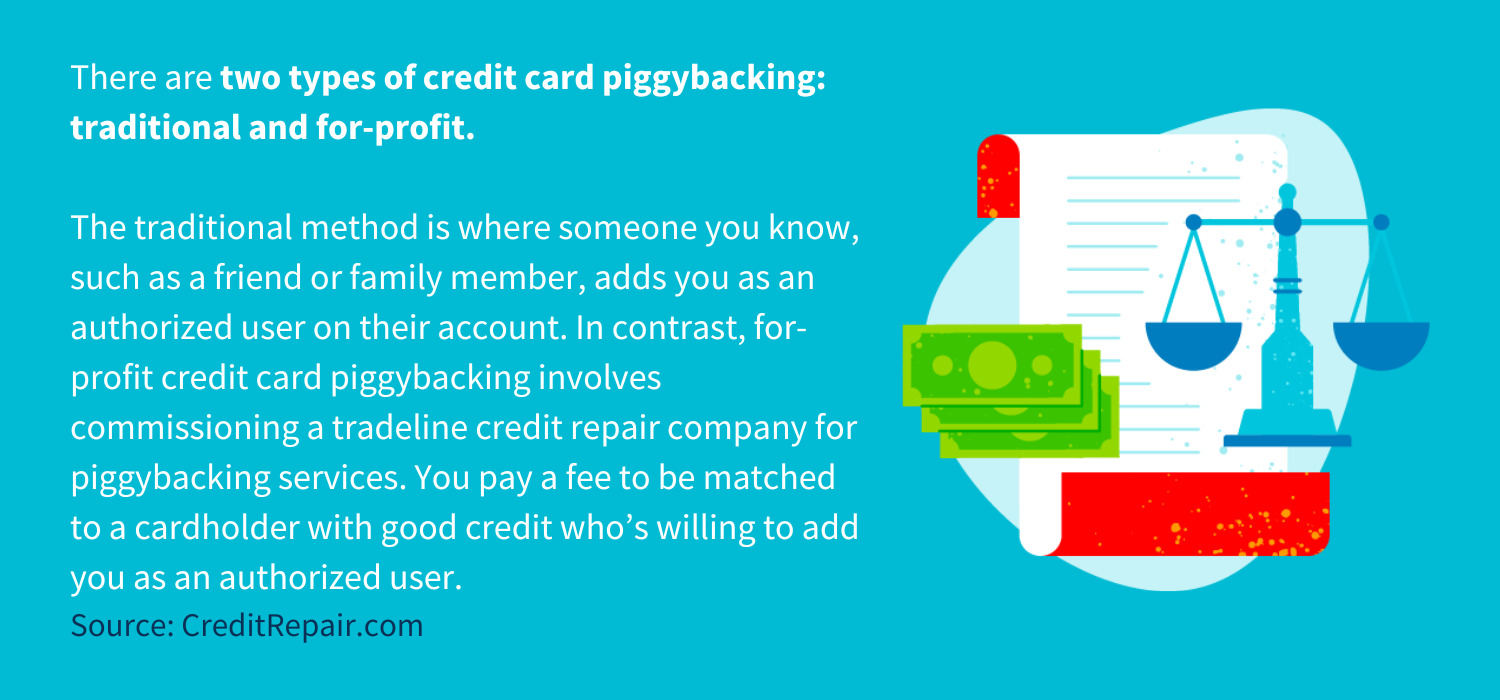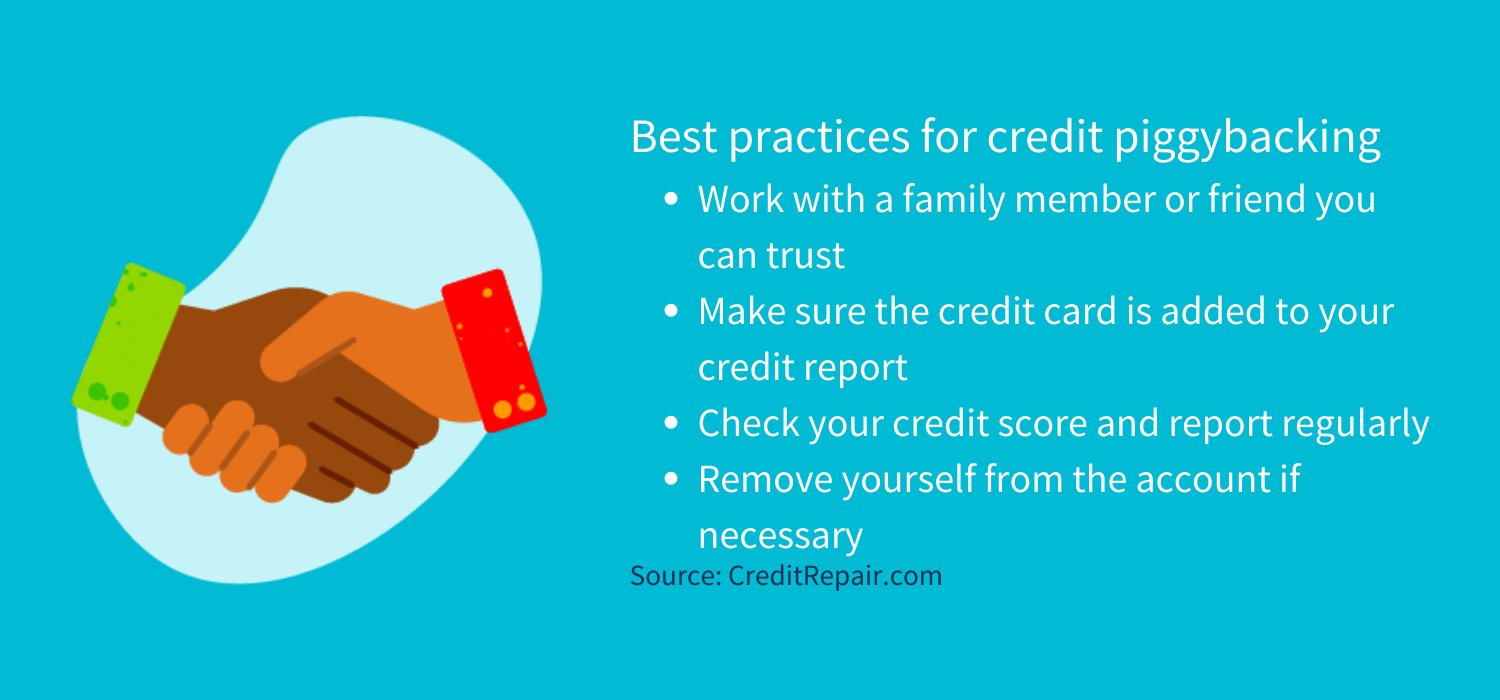
Disclosure regarding our editorial content standards.
If you have poor credit, you may be searching for ways to quickly improve it. One popular method is piggybacking credit repair. If this method is so great, why doesn’t everyone use it? Piggybacking credit repair can work, but it also comes with some risks.
Find out everything you need to know about credit card piggybacking, so you can determine if it’s right for you.
What is credit piggybacking?
Credit piggybacking means being added on to someone else’s credit accounts—usually credit cards—as a way to boost your own credit. As an authorized user, you benefit from the person’s credit data being added to your credit report. So, your credit likely will improve if the person has excellent payment history, a low credit utilization ratio and little to no debt.
The other person is essentially carrying you on their credit piggyback-style, which is how this term got its name. Piggyback credit can be an effective tool to help someone who has no credit or who is trying to rebuild credit to get some positive credit history.
How does credit piggybacking work?
Credit card piggybacking is relatively straightforward. Someone adds you as an authorized user on their credit card. Then, everything related to that card, including payment history and credit utilization, is added to your credit report. As far as the credit card company and the credit bureaus are concerned, as an authorized user, you share the credit history of the card.
However, note that being an authorized user differs from being a joint account holder. A joint holder is responsible for payments if the account owner can’t make payments. Conversely, an authorized user isn’t held accountable for outstanding debts on the account.
Note that you don’t have to use the card as an authorized user. For example, many parents add their children as authorized users on their credit cards when the kids turn 18. The parents don’t necessarily hand over the card for use; they just want to improve their children’s credit scores.
Traditional and for-profit piggybacking

There are two types of credit card piggybacking: traditional and for-profit.
The traditional method is where someone you know, such as a friend or family member, adds you as an authorized user on their account.
In contrast, for-profit credit card piggybacking involves commissioning a tradeline credit repair company for piggybacking services. You pay a fee to be matched to a cardholder with good credit who’s willing to add you as an authorized user. The cardholder gets paid for their services. Since you never receive an actual card for the account, there’s no risk for the cardholder.
Pros and cons of traditional piggybacking
The benefits of traditional piggybacking are clear—your credit score can improve with minimal effort. Additionally, you’re partnering with someone you trust and don’t have to pay them a fee.
However, there are some risks here. You’re adding yourself as an authorized user to someone else’s account and relying on their actions. If they start being irresponsible with their credit and missing or making late payments, your credit will be negatively impacted.
Pros and cons of for-profit piggybacking
The benefit of paying for the piggybacking service is that you know the company has verified the person has good credit.
Of course, the major con with the for-profit option is that it costs money. Also, the other person may start with good credit, but that may change once you’re added as an authorized user.
Additionally, using for-profit piggybacking could increase your risk of identity theft. This is especially true if the tradeline credit repair company doesn’t maintain strict data security practices. Becoming a victim of identity fraud would further damage your credit.
Plus, for-profit piggybacking is a short-term solution. You’re an authorized user for a specific period before you’re removed from the account. After the removal, there’s a high probability your score will drop back down.
FAQs
Is credit piggybacking legal?
Credit card piggybacking is both legal and authorized by the Federal Reserve Board Regulation B and the Equal Credit Opportunity Act. In 1974, the Equal Credit Opportunity Act was created to make sure creditors couldn’t discriminate against any applicant. This act’s allowance of credit card piggybacking was especially helpful to women who could benefit from their husbands’ credit history and begin developing their own credit records.
For-profit credit card piggybacking is controversial in the banking and credit world. In fact, some have blamed this type of service for making credit piggybacking less impactful. After for-profit piggybacking was introduced, some credit-scoring models, such as FICO®, tried to implement measures to reduce their impact. FICO wants to prevent people from being able to pay their way to a better credit score.
How long does credit piggybacking take?
It typically takes 15-45 days to become an authorized user of a credit account. Once the user has been added, the user should quickly see an increase in their credit score.
How much can credit piggybacking help your credit?
The impact of credit piggybacking depends on multiple factors. If you have a very thin credit file or a low credit score, credit piggybacking will significantly impact your credit score. However, if you already have good credit, you’ll likely see less of an increase.
Who can benefit from credit piggybacking?
Credit piggybacking can work if you’re looking for a relatively quick boost to your credit score. Remember, it will have the most significant increase if you have a low to fair credit score. People with limited credit histories or no credit, such as young adults, might also benefit from piggybacking.
Does credit piggybacking still work?
Unfortunately, credit piggybacking isn’t guaranteed to work every time. Some credit card companies choose not to report authorized users to the major credit bureaus. Many smaller banks report authorized users only if they’re the primary cardholder’s spouse. However, the bigger lenders generally report all authorized users.
It’s also important to note that some credit-scoring models, like FICO, disapprove of for-profit piggybacking to improve credit. FICO announced that it modified FICO 8 to protect scores from “potential gaming by this type of piggybacking.” So, while it’s unclear how much this model modification impacts the results of piggybacking, it’s something to keep in mind.
Best practices for credit piggybacking
Piggyback credit can be a relatively easy way to give your credit a boost, but there is a right and there is a wrong way to go about it. Check out the best practices we suggest here.

Work with a family member or friend you can trust
Piggyback credit is a two-way street when it comes to trust. The person who is adding you as an authorized user is trusting you to be responsible with their accounts and not rack up debt. You’re trusting that they will continue their positive payment history.
For this reason, it’s best to consider only close, trusted friends or family members who are familiar with your financial situation and willing to help.
Keep in mind that getting finances involved can make the relationship awkward. Consider having a plan for what you both will do if the situation doesn’t work out as expected.
Make sure the credit card is added to your credit report
You can only get the benefits of credit piggybacking if the account shows up on your credit report. It may take a billing cycle or two to show up, and sometimes, the account may only be reported to one or two of the credit bureaus. If the account doesn’t make an appearance, give the lender a call to find out if they are reporting to the credit bureaus.
Check your credit score and report regularly
If you’re not actually using the account, it may be tempting to just have yourself added and forget it. But out of sight, out of mind is a bad idea when it comes to your credit. Make sure that the accounts are reported—and reported correctly—by regularly checking your credit report.
Remove yourself from the account if necessary
There may be times that you need to remove yourself from a piggyback account. Common situations include the primary credit holder running up the balance on the card or missing payments. Both of these are significant negatives when it comes to calculating credit scores, and being an authorized user on a problematic account can actually lower your score.
How to find reputable credit piggybacking companies
There are a lot of fraudulent “companies” out there pretending to be credit repair organizations that will help you with credit card piggybacking. In reality, they could be running a scam to do any of the following:
Ideally, you should avoid using a credit piggybacking company if you can. Not only is it an expensive, short-term solution, but there are many untrustworthy companies out there.
If you believe the for-profit route is your only option, work with a reputable credit card piggybacking company. You can do the following to verify the legitimacy of the company:
Know that if the company asks for their fees upfront, they’re in violation of the Credit Repair Organization Act (CROA) and shouldn’t be trusted.
Is credit piggybacking right for you?
It’s hard not to be tempted by piggybacking. If you have a reliable source, credit piggybacking can be a quick boost to your credit.
However, keep in mind that credit card piggybacking really has a significant impact on individuals with thin credit files and poor scores. If you have an average credit score, this option probably will do little for your credit and not be worth the effort.
There are plenty of other solutions that can considerably benefit your credit. To find out how you can fix your credit, contact CreditRepair.com.
Note: The information provided on CreditRepair.com does not, and is not intended to, act as legal, financial or credit advice; instead, it is for general informational purposes only.
Questions about credit repair?
Chat with an expert: 1-800-255-0263






